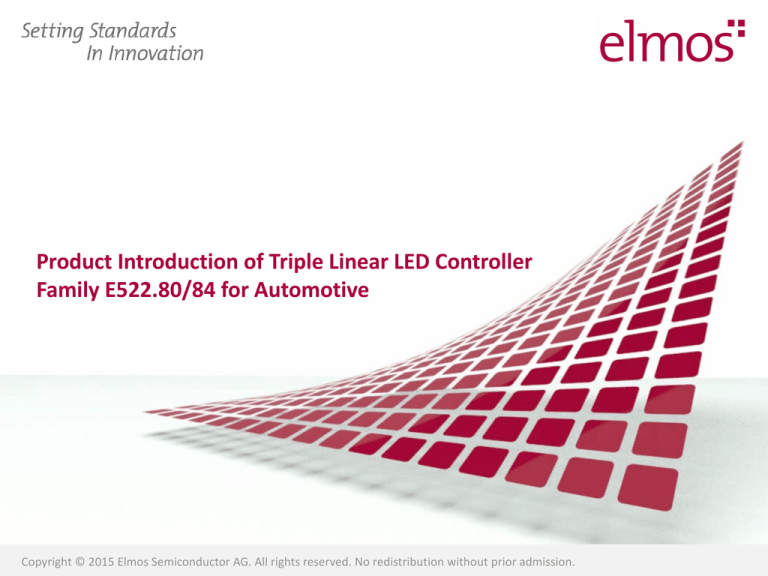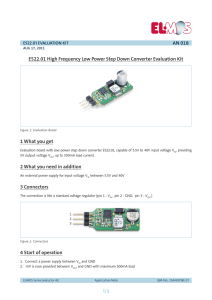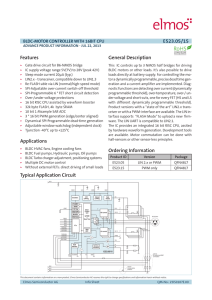
Product Introduction of Triple Linear LED Controller
Family E522.80/84 for Automotive
Copyright © 2015 Elmos Semiconductor AG. All rights reserved. Confidential
No redistribution without prior admission.
Elmos 522.8x Linear LED Controller Family
Evolutionary Introduction to Product Features
E522.8x Linear LED Controller Family
Excerpts of Features in the Datasheet
Source: Elmos
2
Starting Point: Classical Linear LED Control Topology
e.g. for Rearlight Modules
Rearlamp Module
Control
Module
Topology based on Discretes only
A master Driver modulates a PWM signal to via a single supply line
Properties of this implementation are
Source: Elmos
Weak diagnostic features (only total current consumption)
Current in LEDs depends on actual temperature and battery voltage
3
Starting Point: Classical Linear LED Control Topology
e.g. for Rearlight Modules
Rearlamp Module
Control
Module
Topology based on ICs driving LEDs
Compatible interface to the discrete solution
Improvements over the discrete-built solution
Source: Elmos
Diagnostics within rearlamp module are possible
Current in LEDs can be controlled independent of supply voltage
4
Starting Point: Classical Rearlight Module Topology
Exemplary Integrated IC Solution
Parallel ICs operate one or more channels of LEDs in parallel
Usually 2 or 3 LEDs are operated per channel to survive typ. battery drop transients
Source: Elmos
General requirements include operation <150mA, open-detection, short-circuit
detection, over-temperature handling and wide input voltage range
5
Starting Point: Puzzle Pieces for Evolution of IC
Properties
2
1
3
Puzzle Pieces
4
1: How to handle linear power-dissipation?
2: If using a power-shunt, how to provide full current for low supply voltages?
3: Lowside feedback: How can a GND shift (e.g. at connectors) be handled?
4: If diagnostics are available, how can modules behave in a single-bulb manner?
Source: Elmos
6
Piece 1: Internal Power Dissipation of the Driver
?
Question: High Linear Power Dissipation, what can be done?
The linear power in the ICs is directly proportional the to supply voltage
A typical exposed die pad package assembly may provide RTH,J-A of 15...30K/W
Source: Elmos
At VVS supply of 14V and VLED= 6V @100mA the power to be handled is 0.8W,
thus resulting in a rise of ~ 25K/W * 0.8W = 20°C
How can the power be handled for e.g. VVS=18V and ILED=150mA?
=> Power of 1.8W per string in driver IC!
7
Piece 1: Internal Power Dissipation of the Driver
!
Answer: Power can be shared with external Power-Sinks
Export power to some external heat-dissipating element, e.g. a resistor
Power up to ILED2 * REXT can be dissipated in the external element
Source: Elmos
But if handled in this way, ….
8
Piece 2: Low-Voltage Operation
?
Question: How is Undervoltage Behaviour affected?
…. low-voltage performance degrades, because the current becomes limited by the
resistor REXT in case of cranking pulses etc.
How can the under-voltage performance of the linear-regulator be re-covered?
Which way is the open-detection for low supply managed?
Source: Elmos
9
Piece 2: Low-Voltage Operation
!
Answer: A redundant Output Path is provided
Provide a parallel, redundant path for the current flow in case the current cannot be
delivered by the primary output!
The current can be kept fully controlled down to the VLED forward-voltage
… and the thermal performance / distribution features remain
Source: Elmos
10
Piece 1+2: E522.8x High-Power Handling
Power Distribution Principle in E522.80/81/82/83 Applications
Power as a function of V ( VS )
Exemplary for V ( LED ) = 6V and different ext. Shunts
( Single-Channel Calculation, 120mA )
2,00
PLED
P(R1=33Ohm)
P(E522.8x)@R1
P(R2=56Ohm)
P(E522.8x)@R2
P(R3=82Ohm)
P(E522.8x)@R3
1,60
P [W]
1,20
0,80
0,40
0,00
5,0
10,0
15,0
20,0
25,0
30,0
V (VS) [ V ]
Source: Elmos
11
2,00
Piece 1+2: Power Sharing, Zoom and Math
1,60
PLED
P(R3=82Ohm)
P(E522.8x)@R3
P [W]
1,20
PR,EXT
PLED
0,80
„Zero Power #2“
0,40
P522.8x
0,00
5,0
10,0
15,0
20,0
V (VS) [ V ]
25,0
→ If VVS fulfills the condition
VVS =30,0
VFW,LED + ILED * REXT
the power across the driver is
again theoretically „zero“
Intermediate Power-Maximum
„Zero Power #1“
→ Below conducting voltage VFW,LED
of the LED, there is theoretically
no drop-voltage across the driver
Source: Elmos
→ The maximum power occures, if half of
ILED is driven by the bypass ouput, thus it is
¼ of the maximum resistor power ILED2 * REXT
(half of the current times half of the voltage)
12
Piece 1+2: E522.8x High-Power Handling
VREF
VREF,NOM
dVJ,DERATE
Nom. Operating Range for
external VREF = VENA /2
VENA,ON /2
-40°C
Limited
by abs.
max. Ratings
522.8x disabled by ENA
TJ,DERATE
150°C
TJ,OT
TJ
Internal Derating of Reference „regulates“ Junction Temperature
Internal derating function limits the reference voltage provided at IR to generate
reference-current for the LED Driver
Typical numbers: TJ,DERATE = 138°C and dVJ,DERATE = 26,7mV/K @ VREF,NOM = 1.5V
Source: Elmos
13
Piece 1+2: E522.8x High-Power Handling
VREF
VREF,NOM
dVJ,DERATE
VIN Overvoltage Reference Derating
0.6 * VREF,NOM
Over-Voltage Operating Range for
external VREF = VENA /2
VENA,ON /2
-40°C
Limited
by abs.
max. Ratings
522.8x disabled by ENA
TJ,DERATE
150°C
TJ,OT
TJ
Internal Derating of Reference decreases at excessive VVS
In case the supply voltage at VS exceeds 27V, the internal reference voltage derates to
60% of nominal level VREF,NOM
The maximum power in the package is kept below a given maximum at VVS = 27V
Source: Elmos
14
System Design: “Open Detection” Concepts
based on either relative Voltage or Current?
Issue : Relative Voltage System :
ILED
ISPAN,VOLT
MIN
Simple and intuitive implementation approach, usually
relative to the supply voltage
Drawback: Usually IC vendors do not specify the
remaining current flow at the „open threshold“→
information not available for system designers
TYP
MAX
VLED,MIN,V
VLED,MAX,V
VLED
ILED
Solution :
Relative Current Threshold in
E522.8x :
ISPAN,CUR
MIN
TYP
MAX
VLED,MIN,C
Source: Elmos
Wide window for max. potential LED voltage to be
considered, even if the remaining current
tolerance is known !
VLED,MAX,C
VLED
More precise, narrow current-span can be taken into
account by system engineers
Maximum forward voltage at LEDs way better
defined, allowing more precise description of lowvoltage behaviour of the system !
15
Piece 3: Current Configuration and Feedback
?
Question: What Ground Potential Difference can be handled?
Is „cathode-to-GND“ Topology possible?
For e.g. the use of connectors or even wiring to connect LEDs within rearlamp a
feedback can be critical regarding GND potential differences between driver circuit
and LEDs
Dual-wire interface per string potentially necessary to avoid GND differences
Compensation capacitors may be required or limiting the freedom of designers choice
Source: Elmos
16
Piece 3: Current Configuration and Feedback
!
Answer: GND at LEDs as reference potential is not required,
and „cathode-to-GND“ Topology is possible
The configuration can be made via a single, low-power resistor connected to the
controlling IC. The current source becomes a true current source
Cathode-To-GND topologies provide handling of connectors and wire resistances
Reduced the minimum operation supply voltage by the amount of feedback voltage
Source: Elmos
17
Piece 4: Behavior of a Single Bulb in case of Failures
?
Question: How can the Fault-Behavior of a Bulb be
immitated by a LED Cluster?
Failure information must be distributed between ICs
Restart mechanisms must be available to avoid deadlock situation
Important: Glowing or glimming of LEDs must be prevented
Source: Elmos
18
Piece 4: Behaviour of a Single Bulb in case of Failures
?
Question: How many Components are necessary?
There are solutions on the market, that may require 20...30 external discretes.
LEDs are potentially glowing due to lack of option to store failure information
Source: Elmos
19
Piece 4: Behaviour of a Single Bulb in case of Failures
!
Answer: No external Components are required for “Single Bulb!“
A private bus connects all ICs, distributing the information of a failure on a channel
All ICs enter low-power standby mode, allowing the control module to diagnose via
current consumption only!
Failure information is stored as long as VVS remains, thus preventing glowing effects
Source: Elmos
20
Piece 4: Statediagram Excerpt from Datasheet
Global, Prio 1:
VVS < VVS,ERR
VS RESET
Global, Prio 3:
if all [ y ] are statically
disabled for 64ms
RUN active low
SLM set to pulldown
LED Outputs pulldown
IR Driver off
ERR[ 2:0 ] = '000'
Global, Prio 3:
RUN pullup enabled
and RUN state 'Low'
Thermal
Shutdown
Global, Prio 2:
Junction OverTemperature
Two ways to handle FaultDetection:
RUN active low
LED Outputs pulldown
IR Driver disabled
Overtemperature
Recovery
Global, Prio 2:
ENA Low
VVS > VVS,ERR
Standby Mode
ENA High
No ERR stored
RUN pullup enabled
LED [ x ] pulldown
IR Driver off
ERR[ x | ='0'
Sleep Mode
RUN active low
All LED pulldown
All IR disabled
SLM driving low
ERR[ 2:0 ] unmodified
RUN
High
All ERR [ y ]
cleared by
Diagnosis
After 6ms :
Re-Diagnosis at
enabled [ y ]
for 64us
Rising VIR,X > VIR,DIS
Channel [ x ] disabled
→ Transition
[x→z]
Active,
„Failure Feedback Mode“
RUN active low
LED, IR [ x ] enabled
Diagnosis for [x] active *)
LED, IR [ y, z ] disabled
ERR [ y ] set to '1'
Re-Start Counter running
SLM driving PWM
Falling VIR,Y,Z < VIR,DIS
Channel [ y or z ] re-enabled
With 64us ERR tolerance
Transition [ y, z → x ]
ENA High,
ERR flag stored
any VIR,Y < VIR,DIS
RUN active low
LED, IR [ y ] enabled for 64us,
if VIR,Y < VIR,DIS *)
SLM driving low
Other channels in [ z ] state
Any ERR[ y ]
still present,
SLM held low
Any ERR[ y ]
still present,
SLM high
ERR [ y ] flag
cleared by
Re-Diagnosis
ERR at channel [ y ]
SLM held low
ERR detected
at channel [ y ≠ z ]
SLM held low
Active,
Full Diagnosis
RUN pullup enabled
LED, IR [x] driving *)
( if VIR,X < VIR,DIS )
→ SLM drives high if
ERR[ x ] = '1' after 64us
After 64us:
No ERR[ x ]
detected
Active,
Selective
Diagnosis
ERR at channel [ y ]
SLM driven high
Standby
„Single Lamp“
Mode, Counting
RUN active low
All LED Outputs pulldown
All IR Drivers disabled
SLM driving high
→ ERR [ y ] set to '1'
Re-Start Counter running
ERR detected
at channel [ y ≠ z ]
SLM driven high
Active Mode.
Normal Operation
Index Usage:
x: Active Channel [2:0]
y: Faulty Channel [2:0]
z: Disabled Channel [2:0]
Rising VIR,X > VIR,DIS
Channel [ x ] disabled
→ Transition [ x → z ]
RUN pullup enabled
LED,IR [ x ] driving
Diagnosis at [ x ] enabled *)
LED,IR [ z ] disabled
SLM driving low
if all ERR [ x ] = '0'
Channel [ y ] re-enabled
by either falling VIR,Y or
Re-Start Counter ( 6ms )
( VIR,Y < VIR,DIS )
Falling VIR,Z < VIR,DIS
Channel [ z ] re-enabled
With 64us ERR tolerance
Transition [ z → x ]
Need a simple, downward
compatible cluster?
E522.8x can be configured to
operate in „Single-LampMode“ to allow simple LEDcluster definition !
Need more feedback?
E522.80 be set into failure
feedback mode,
providing the channels with
fault-detections !
*) „LED Open“ error
diagnosis is active
only in case VVS > VTST
Source: Elmos
21
Before and After Comparison of Topologies
2
?
1
Starting
Toplogy
3
4
?
2
1
3
4
Source: Elmos
22
E522.80 Product Family Features
Features of E522.80 / 81 / 82 / 83
Three independent Linear Current Drivers ( 3*150mA ),
allowing parallel Output Operation for up to 450mA
Independent Thermal Management Option per Channel
Operating Input Voltage Range 5V to 25V, max. 40V and
Low Power Standby / Sleep Mode of typ. 12.5µA per IC
External Reference Voltage / Derating supported
PWM Dimming (all channels or separate Channels)
Load Diagnostics ( LED Driver Open/Short, IR Config Open/Short, Junction Temperature,
Supply Voltage ) featuring relative Open-Detection Currents per Driver
Diagnostic Bus to link ICs for a combined Fault-Reaction in "Single Lamp Behaviour" plus
alternative Option to read back the faulty Channels via PWM protocol
Narrow SO16 Package with Exposed Pad for low RTH,J-C
Source: Elmos
23
E522.80 Product Family Features
What´s the family members
Difference?
Family Members provide different
levels of VVS,DIAG to adapt to
the level of voltage VLED,MAX
that is needed to operate the LEDs
Product Version
VVS
Nominal System Operation
- Full Diagnostic
- Full LED current available
Typ. VVS,DIAGx
VVS,DIAG
E522.80
7.5V
VLED,MAX
E522.81
9V
VLED,MIN
E522.82
10V
E522.83
15V
Open Detection Monitor Enable Tolerance Window
LED Voltage Tolerance Range for Open Current
Non-Operating Range
(LEDs not conducting)
0V
Source: Elmos
24
E522.81 Automotive Cluster Example
E522.81
1
RUN
LED1B
VS
LED1A
GND
LED2B
ENA
LED2A
IR1
LED3B
IR2
LED3A
IR3
SLM
2
E522.81
3
4
Source: Elmos
RUN
LED1B
VS
LED1A
GND
LED2B
ENA
LED2A
IR1
LED3B
IR2
LED3A
IR3
SLM
5
25
E522.81 Automotive Cluster Example
E522.81
1
RUN
LED1B
VS
LED1A
GND
LED2B
ENA
LED2A
IR1
LED3B
IR2
LED3A
IR3
SLM
Cloud 1:
2
E522.81
3
4
RUN
LED1B
VS
LED1A
GND
LED2B
ENA
LED2A
IR1
LED3B
IR2
LED3A
IR3
SLM
5
or to define an undervoltage
threshold using bandgap
accurate enable handling
Cloud 2:
Source: Elmos
Power Supply Dimming is
possible. The Resistive
divider can be used for
analog low-voltage current
derating …
Seperate Current configuration
per channel allows different
currents and digital dimming
per channel
26
E522.81 Designers Reference Generation Options
ENA
Current Configuration
+
1.2V
VREF,NOM
ENABLE
-
VREF,HV
VS Overvoltage
Channel
Current
Reference
250kW
+
+
+
-
250kW
IRX
VIR,DIS
-100mV
Internal
Temperature
Derating
+
VIR,DIS
Source: Elmos
-
6V
Channel
Disable
Different Mechanisms define the
voltage that is applied to the
current configuration resistor
The internal amplifier accepts the
lowest reference applied and
re-produces the voltage at IR
driver pin
Potential Sources are:
Voltage at ENA
Linear temperature derating
at typ. TJ > 138°C
For excessive VVS the
reference is derated to
60% to decrease power
27
E522.81 Automotive Cluster Example
Cloud 3:
E522.81
1
RUN
LED1B
VS
LED1A
GND
LED2B
ENA
LED2A
IR1
LED3B
IR2
LED3A
IR3
SLM
Cloud 4:
2
E522.81
3
4
Ceramic type inductive supply
handling / damping proposal
RUN
LED1B
VS
LED1A
GND
LED2B
ENA
LED2A
IR1
LED3B
IR2
LED3A
IR3
SLM
5
Simple permanent disable
option if less than 3
channels of E522.8x are
used
Cloud 5:
Source: Elmos
Parallel operation of channels
for single high-power LED
separated by connector or
wiring
28
E522.8x Product Family Extension
Features of E522.84 / 85 / 86 / 87
Extension IC for System-designers to driver smaller Currents per channel
Three independent Linear Current Drivers ( 3*60mA ),
allowing parallel Output Operation for up to 180mA
Low-RTH SO8EP Package for cost-optimized integration, no external thermal sinks needed
All channels configured via a single resistor
Dimming via Supply
RUN concept compatibility to the higher current family E522.80
Same diagnostics features as for E522.80
Source: Elmos
29
E522.8x Product Family Extension II
Outlook
Interested in lower currents, but need the full feature set of E522.80 ?
Like to discuss your system-concept with product-experts ?
Get in contact with Elmos – we support your ideas !
Datasheets are available on www.elmos.com/.....
Source: Elmos
30
Disclaimer / all material shown is based on assumptions and actual views of Elmos
Semiconductor AG and may be adapted without further notice, depending on
market situation or technical requirements as necessary, up to discontinuation
of products presented herein. Schematics or drawings do not imply full
compliance to customer requirements and are to be evaluated
or used on own responsibility
Elmos Semiconductor AG
Heinrich-Hertz-Str. 1 | 44227 Dortmund | Germany | phone: + 49 231 75
49 100 | fax: + 49 231 75 49 149 | info@elmos.com | www.elmos.com
Confidential






